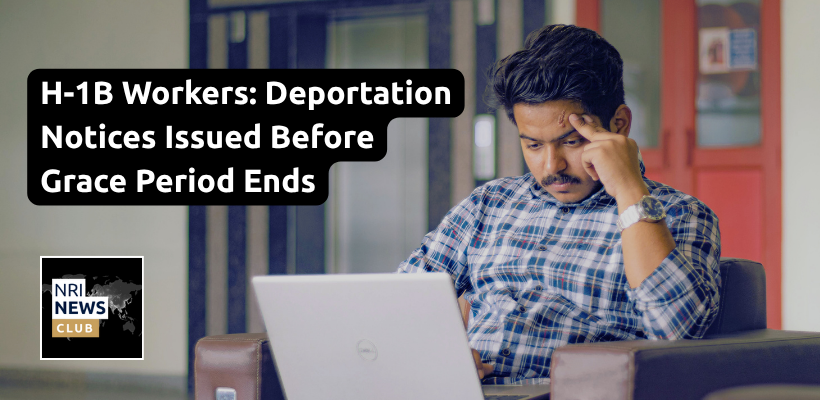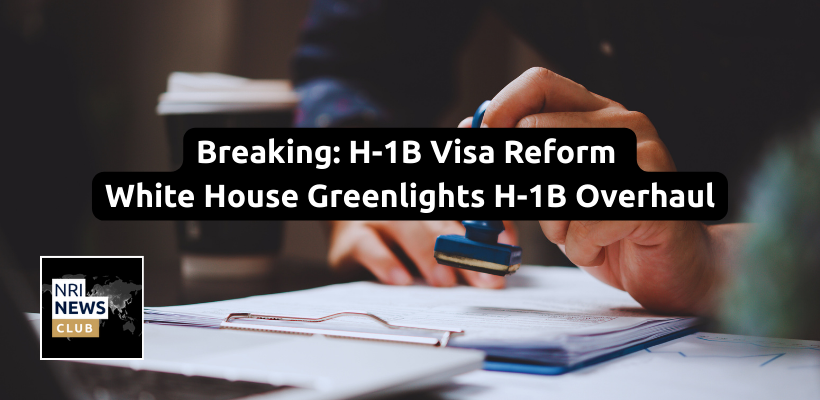In a concerning development for foreign workers in the United States, laid-off H-1B visa holders are receiving Notices to Appear (NTAs) from the U.S. Citizenship and Immigration Services (USCIS), even within the legally mandated 60-day grace period following job termination. This practice, which appears to contradict established USCIS guidelines, has sparked alarm among immigration advocates and legal experts, particularly as it coincides with stricter immigration enforcement under the Trump administration.
The 60-Day Grace Period: A Supposed Safety Net
Under current H-1B visa regulations, when a worker’s employment ends, whether voluntarily or involuntarily, they and their dependents are granted a 60-day grace period to remain in the U.S. This period, outlined in 8 CFR 214.1(l)(2), allows individuals to secure new employment, file for a change of visa status (such as to B-2 visitor or H-4 dependent status), or prepare to depart the country. The regulation explicitly states that H-1B workers “shall not be considered to have failed to maintain nonimmigrant status solely based on a cessation of the employment” during this time.
However, a clause in the regulation grants the Department of Homeland Security (DHS) discretionary authority to “eliminate or shorten these 60 days.” According to recent reports, this discretion is being exercised more frequently, leading to the issuance of NTAs; formal documents that initiate deportation proceedings before the grace period expires.
Rising Concerns and NAFSA’s Report
The Association of International Educators (NAFSA) has highlighted this troubling trend, noting that some H-1B workers are receiving NTAs despite being in compliance with visa rules. These notices, formally known as Form I-862, outline the legal grounds for deportation and require recipients to appear before an immigration judge. The issuance of an NTA effectively places individuals in removal proceedings, rendering them “unlawfully present” and complicating their ability to transfer to a new employer or adjust their visa status.
Immigration attorney Sameer Khedekar, founder of Vanguard Visa Law, emphasized the severity of the situation: “Upon lay-off, a 60-day grace period is available to an H-1B visa holder who either transfers the H-1B status to a new employer or applies to change his/her visa status before the grace period ends. However, increasingly the Department of Homeland Security is sending NTAs in immigration courts, even when the laid-off H-1B worker has a change of status application pending.”
Rajiv S. Khanna, another prominent immigration attorney, pointed out that USCIS guidance issued on February 28, 2025, specifies that NTAs should only be issued after an unfavorable decision on a benefit request and when the individual is no longer in lawful status. “Recent cases demonstrate USCIS improperly issuing NTAs to individuals who remain in ‘authorised periods of stay,’ including those with pending change of status applications,” Khanna noted.
A Surge in NTAs
According to a USCIS disclosure, approximately 1,840 NTAs have been issued weekly since February 2025, with many targeting individuals who appear to be in compliance with immigration rules. Legal experts argue that this practice not only violates USCIS policy but also creates significant distress for affected workers. For instance, cases have been reported where H-1B workers who filed timely change-of-status applications, such as to B-2 visitor status received NTAs before USCIS adjudicated their applications. In one extreme case, an individual who had already left the U.S. voluntarily after job termination still received an NTA.
The implications of receiving an NTA are profound. Once deportation proceedings begin, individuals lose the ability to simply transfer to a new employer or adjust their status without navigating complex legal proceedings. Moreover, being labeled as “unlawfully present” can trigger reentry bans, potentially barring individuals from returning to the U.S. for years.
Impact on H-1B Workers and the U.S. Economy
The aggressive issuance of NTAs has raised concerns about its broader impact on skilled workers and the U.S. economy. H-1B visa holders, often employed in critical industries like technology and healthcare, contribute significantly to innovation and competitiveness. The uncertainty caused by premature deportation notices could deter global talent from pursuing opportunities in the U.S., especially as countries like Canada and the UK offer more predictable immigration pathways.
Immigration advocates argue that this trend represents a breakdown in trust between the immigration system and the skilled professionals it is designed to support. “This conflict between written policy and enforcement practice has left hundreds of thousands of skilled workers and their families in an intolerable situation,” said a statement from TerraTern, an immigration-focused news outlet.
Legal and Practical Recommendations
Immigration attorneys are urging affected H-1B workers to act swiftly to mitigate risks. Recommended steps include:
-
Securing New Employment: If possible, find a new employer to file an H-1B transfer petition within the 60-day grace period. H-1B portability rules allow workers to begin employment as soon as a new petition is filed with USCIS.
-
Filing for a Change of Status: Apply for an alternative visa status, such as B-2 (visitor) or F-1 (student), to extend lawful presence in the U.S.
-
Seeking Legal Counsel: If an NTA is received, contact an immigration attorney immediately to contest its issuance, as some NTAs may be dismissed if deemed erroneous.
-
Documenting Compliance: Maintain meticulous records, including pay stubs, termination notices, and USCIS receipts, to demonstrate lawful status.
For those unable to secure new employment, options like the EB-5 investment program have been suggested as a pathway to permanent residency, though this requires significant financial resources.
Calls for Clarity and Reform
The lack of updated guidance from USCIS has exacerbated confusion among H-1B workers and employers. While the Biden administration had previously encouraged status changes during the grace period, no new instructions have been issued under the current administration. Legal experts are calling for USCIS to clarify its enforcement practices and address what some describe as “administrative errors” or a deliberate shift in policy.
As the situation unfolds, the plight of H-1B workers underscores the fragility of nonimmigrant visa programs in an increasingly restrictive immigration environment.
For the latest updates on immigration policies, visit USCIS.gov or consult a qualified immigration attorney.
Read More:
🔗 U.S. Visa Challenges for Indians in 2025: Why NRIs Are Facing Tighter Immigration Policies
🔗 U.S. Embassy Warns Indian Travelers: Overstaying Visa May Lead to Severe Consequences
🔗 TCS Layoffs 2025: How AI, Global Shifts, and U.S. Policy Impact NRIs in Tech
🔗 Microsoft CEO Satya Nadella Addresses Layoffs, Reaffirms AI-Driven Mission






